Crustiest ‘acean of the seven seas.!!!UPDATE MAY 2020!!! I have advised that I only hold title in six of the seven seas pending results of this year’s crust-off
Don't wanna be here? Send us removal request.
Photo
This week was the first time that I enjoyed the alternate media more than the reading. The concept of a masterpiece is something I have fumbled with from time to time when whim and ego collide and I contemplate living in a van building multi-use wooden furniture by hand. Mastery as a goal I have not seen to be sustainable. The closest competencies that I had (prior to this definition crisis) to mastery were generated as a byproduct of opportunity and necessity. I didn't set out to be a hyperbaric chamber whiz and I oddly enough didn't seek to become a high-order-explosives expert. Those things came from places of service. I saw a need of the people around me and I made myself uncomfortable in hopes that God lead me back to the trough it I wandered too far astray. After this assignment, I think mastery is like bliss. It’s never truly attainable (at least in the world that we currently occupy) as it is so relative and elusive in denotation.
Cheers,
Calvin

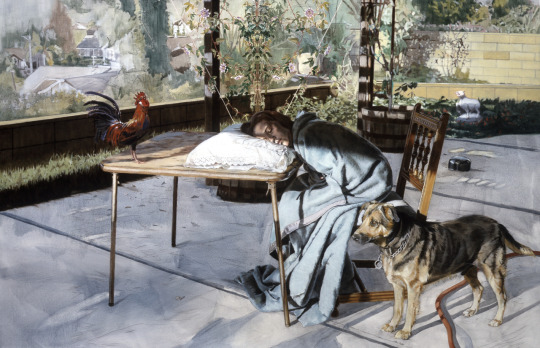
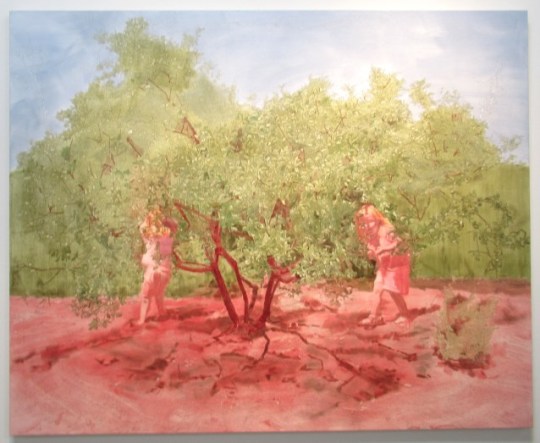
youtube
Masterpieces
For our final week of the why unit of Creative Christian, take some time to thoughtful consider and reflect on the following content:
1.) Read Imagine (The Mind) pages 100-115
2.) Read Matthew 25:14-30
3.) Watch “What Makes a Masterpiece?”
Please post your reading responses to this content on your blogs before our discussion on Wednesday.
Images above:
week 6 reading assignments infographic
Patty Wickman “The Passion”, oil on canvas.
Patty Wickman “Circumscribe”, 2019, oil on linen, 84 x 104".
Patty Wickman is an artist of faith living and working in Los Angeles. Image Journal describes the artist this way:
“Patty Wickman is a painter who creates haunting scenes- and we mean haunting in the old-fashioned sense: suffused with awe and transcendent mystery. She combines pictorial realism with two related concerns: close observation of human psychology and an abiding sense that psychology must be complemented by something else, something that can only be called spirituality.”
Read the full article on the artist, linked here.
You can learn more about Patty Wickman in her own words in this 2019 interview from Art & Cake.
youtube video “What Makes a Masterpiece?” from The Art Assignment
2 notes
·
View notes
Photo
I would suppose my belief is closer to iconoclastic when it comes to depictions of God as a teaching guide for the masses. It is one thing to guess as to what He may be like, but it is another to say this is what He looked like.
I will say, however, I strongly revolt against the destruction of religious/historical works solely due to political motive or without due process. This is bred from basic physical science concepts. It is much easier to build initially than it is to un-destroy a work.
I had a professor recently consider it necessary to censor the genitalia of a famous oil painting. This, in my certainly skewed opinion, weaponizes the nether region of that particular subject. No rational human was thinking that the intent of the professor was anything other than to add to the lesson plan through pertinent and perhaps-known visual aids. A group of grown college students should not have to be treated with the same sheltering instinct we share for rearing toddlers. The older I get the grumpier I get. Pay no mind to me, I’ll be on the shuffle board deck.
As overlapped in one of the questions of the week here https://tomhankshaslazervision.tumblr.com/post/630060334311424000/societal-roles-of-art-i-think-the-most-vital, I believe the most unique, but most universally applicable, capability of art is its potential to activate an empathic window into so many other societies (and subsets within those societies). We have a need to create, this has led to some of the most significant historical insights into various societies solely through pottery or other artistic artifacts.
Cheers,
Calvin



youtube
Iconoclasm and Art’s Empathetic Power
Christianity historically has taken two extreme positions in terms of the arts, one where Christians are exalting art and another where they are rejecting and destroying it. Devotion to God has inspired both pilgrimages and the smashing and burning of art. The historical debate of the iconoclasts and the iconophiles sheds some light on why Christians today can have some difficulty knowing how to best engage with the arts.
Gene Edward Veith Jr. puts it like this:
“The theological debates between the iconophiles (lovers of religious images) and the iconoclasts (destroyers of religious images) began in the earliest days of the Christian church, erupted again during the Reformation, and they continue today. That both icon makers and icon breakers have been a part of the history of the church suggests that both may have a certain grounding in Biblical truth. The iconophiles may well be correct in valuing art (although they perhaps take this value to an unbiblical extreme). The iconoclasts are also correct in refusing to worship it (although they perhaps take this fear of images to an unbiblical extreme.) By putting the views together and allowing them to correct each other, we can learn from both factions.”
This is a complex history beyond the scope of my own expertise or that of the context of this course, a history that you can study in more depth in art history. However, I think a basic introduction to these concepts offers rich insights into our conversations about the why we are interested in exploring as visual artists and creatives over the next few weeks.
Please check out this blog post about the basics of Icons & Iconoclasm and this blog post about the debate between the iconoclasts and iconophiles before Wednesday.
For your reading this week, please also take some time to read and consider the points expressed in the PDF uploaded to moodle this week called “Art and an Integrated Worldview”.
Lastly, please consider the content of the video above “Art and Empathy” which explores one of the things that art can sometimes do really well: help us to empathize, even care, about the lives and experiences of others. As we consider why art matters, this video is one argument for the value of art in our world which relates to some of the fear early christians had about art’s power. and how to best protect themselves from any sinful engagement with it.
What do you think? Do you identify stronger with the positions of the iconoclast or the iconophile? Where is the line where engaging with an artwork becomes idolatry? Can you give any examples to help explain your thoughts or perspective?
What does idolatry look like in an artwork? How do you identify it? What strategies do you employ to avoid idolatry in your art making and art viewing?
How does being a Christian inform you’re thinking about the value of art? How does being an artist inform your thinking about your faith?
Use this week’s reading response as an excuse to spend some time considering this information and discovering where you position yourself within the conversation. Post your thoughtful reading response post to your blog by Wednesday to help prepare you to get the most benefit from our in class discussion this week.
Images above:
two screenshots from Art & Empathy by the Art Assignment
Four Icons from a Pair of Doors (Panels), possibly part of a Polyptych: John the Theologian and Prochoros, the Baptism (Epiphany), Harrowing of Hell (Anastasis), and Saint Nicholasearly, 15th century.
“Art & Empathy” on youtube
2 notes
·
View notes
Photo
I believe this inquiry is reminiscent of last week’s conversations and questions of the week. The glory of God, as a motivation, exists only purely when ego is eliminated. This is no small feat! As always it comes down to the artist’s intent. This is not accurately measurable to our peers, but we will be accountable in this life and the next.
If art brings about any positive change or impact that aligns with God’s explicit commands, I believe the artist would be in safe territory if the intention is to glorify, celebrate, teach, or learn about faith. These seem fairly cut-and-dry, but I’m no judge.
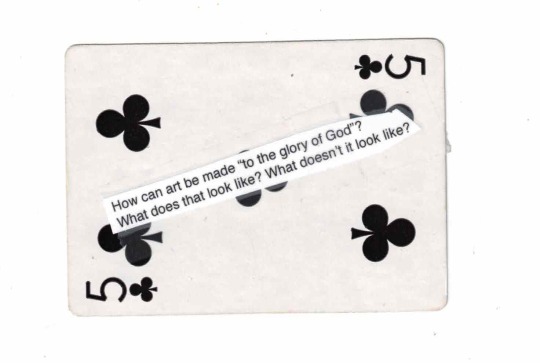
Question of the Week:
How can art be made “to the glory of God”? What does that look like? What doesn’t it look like?
4 notes
·
View notes
Photo
Art should be used carefully in the church. There is celebration and worship. There is also trying to take the job of the Holy Spirit through lavish services with KISS style light-shows and pyrotechnics set to the techno version of Our God Is An Awesome God. Art was used at the height of its utility in the days of an illiterate congregation and stained-glass script scenes. I don’t know where the perfect point between the two extremes in the aforementioned examples, but I know it exists as a necessity.
God renews our minds by the masses through scripture and events but He doesn't neglect the individual by any stretch of the imagination. I am obstinate and strong-willed. My wife is an incredibly patient woman. The times that I look back at what I interpret to be His guidance, they were always progressive in severity. Things most usually begin proceeding for unbearable before I gain the temporary wisdom to assess my alignments and motives. All that to be said, He renews us adeptly.
Cheers,
Calvin
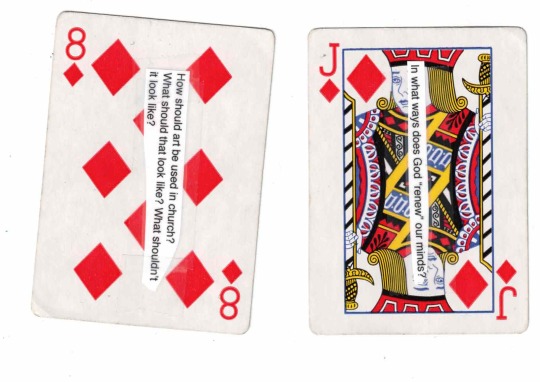
Questions of the Week:
How should art be used in the church? What should that look like? What shouldn’t that look like?
In what ways does God “renew” our minds?
2 notes
·
View notes
Photo
In my mind there are two relevant groups that I subconsciously classify member of the “art world” into. There is the capitalistic chain of command; including but not limited to the artist, sales personnel, gallery/venue owners, and of course the consumer/investor. The other conjured image is that of a battle front. Artists of all different disciplines slam into one another’s ideology of what is art, where is it from, and where is it headed.
The answer to the second question is simple; yes.I think the question is irrelevant (to me), as I haven't scrolled through paintings and elected to apply theological filters in order to funnel down to what it is I am looking for. I believe the impact that faith has on Christian artist is similar to that of a Christian viewer. In either case, it is up to the individual’s circumstance as to how/if faith permeates aspects of their art/life.
Cheers,
Calvin
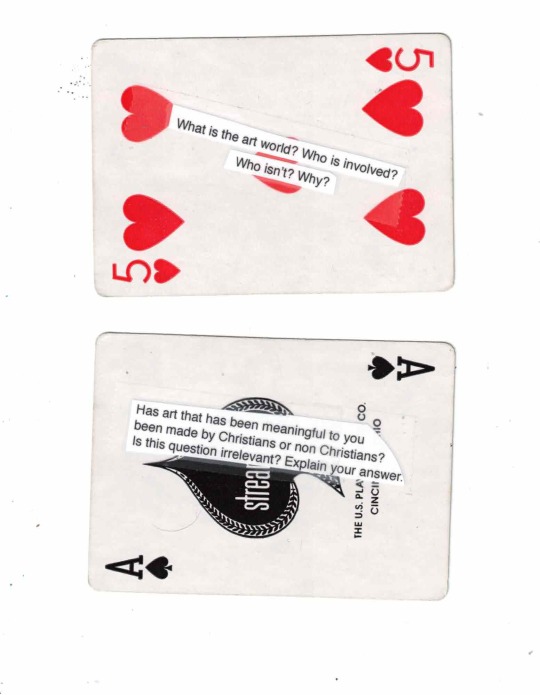
Questions of the Week:
What is the art world? Who is involved? Who isn’t? Why?
Has art that has been meaningful to you been made by Christians or non Christians? Is this question irrelevant? Explain your answer
4 notes
·
View notes
Photo
Firstly, the art I tend to view is almost always superior to my own. This is a good thing to me. I seek the opportunity to grow and if an abundance of artists are more skilled than I, it would seem I have a trodden path to follow. I’m a huge advocate that you can learn 90% of the necessary skills to be employed, successful, and independent on YouTube. In short, there are no excuses for a lack of competency. If it matters, get better.
Secondly, I would say I look for new styles or concepts that clash with my take on something. I have spent a guilt-worthy amount of time marveling at tattoo pioneers and what they do differently from their salty sailor jerry mentors. The same can be said of thumb-scrolling through reams of mathematical art to pass the time. It circles back to growth opportunity. If I only look at the things I wish to improve in my process, as opposed to entertaining entirely different methods, then I will steadily work myself into a very narrow (but deep) swath of competency. I prefer to not be restricted in my capability.
The most direct guidance I’ve found from scripture is to ensure not to (un)intentionally glorify idols or blaspheme the Holy Spirit. This is something I have tried to apply to other facets of my life such as large purchases, choosing mentors, etc. with some success.
Cheers,
Calvin
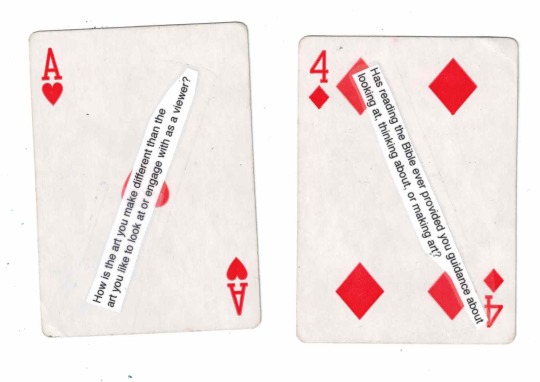
Questions of the Week:
How is the art you make different than the art you like to look at or engage with as a viewer?
Has reading the Bible ever provided you guidance about looking at, thinking about or making art?
3 notes
·
View notes
Photo
Firstly, I don’t believe the distinction to be of importance from a viewer/consumer stance. It is a necessary distinction if the artist depends/relies on a feedback response in some manner (e.g. artist that needs their income from gigs(s)). I would not hang all of the things that I have painted/kept over the years in my living room. One obvious reason is that some of it I simply don’t like enough. The other significant filter is that I wouldn't subject my children to the content of some of the things I have painted; at least not yet. That is the closest I can attain to an empathetic parallel. I assume though if art were intwined enough with my life to the extent to which I am designing gallery pieces, I would potentially have a different opinion on what content is deemed acceptable; leading to hanging some very tasteful nude paintings in the room where my boys’ do the bulk of their play time.
My ideas come from things fitting together as seamlessly as possible. That has an obvious implication toward things such as designing and stick-building my fireplace. However, I find that it extends to finding the exact word required to describe something accurately and efficiently. In short, my ideas come from the motorized hamster wheel of a brain that God gave me. It’s not the traditional pathway, but I dig it.
#questionoftheweek #week6

Questions of the Week:
What is the difference between an artist making art for a gallery and an artist making art for their living room? Does this distinction matter? Why or why not?
Where do your ideas come from?
4 notes
·
View notes
Photo
The personal history of an artist is simultaneously pivotal and inconsequential. It is impossible for the viewer to not pick up on some of the artist’s personality. Whether this is simply perceived by happenstance or as an agenda is also unimportant. Whatever the artwork may be, it was made by a human uniquely shaped by individual and societal circumstance.
Imagine that you are standing alone in a section of gallery in front of a painting that conjures a rather strong emotional response. If you were to be informed, without removing your eyes from the work, that the artist came to America through religious asylum. Would this have an impact on what you see? No. Could it have an impact on how you see it? Certainly. This is because art can be consumed in layers.
Walking through a gallery without knowing anything of the artists or subject isn’t a bad thing. However, it would be akin to picking a random book from the library shelf and flipping from illustration to illustration without reading any of the context. You appreciate the aesthetic. Perhaps you can identify facets of the subjects unassisted. The illustrations will gather a life all their own when the story is read along side. It is the same with knowing the subject or details of the artist.
#questionoftheweek #week8

Questions of the Week:
If a Christian works as an artist, is the art they produce a ministry or an occupation? Why?
How important is knowing the personal history of an artist when viewing their artwork? Does knowing an artist’s religion change the way you understand or appreciate their work?
2 notes
·
View notes
Photo
These are two topics that easily merit their own discussion forums. I believe the greatest advantage of a Christian in the arts resides in a type of confidence few others artists are able to enjoy. If applied correctly, I think the unconditional love of the Creator would serve as a shield that could deflect, or at least dampen the blow of, much of the criticism and doubt that comes with the job.
I have found that I was annealed by the irrevocable nature of God’s relationship with me. Worldly possessions are not durable, but strangely enough neither are the sticks and stones of this world. Perhaps I've simply subjected myself to enough mental masochism that I find adequate respite in that there is an end to any pain/woe of this world; not only this but there is an unimaginable joy to follow for eternity thereafter. In my opinion, this would take much of the sting out of a boisterous viewer describing your effortful work as “$#@^”.
That being said, I believe there is a unique barrier of entry in addition to a narrower breadth of social acceptability for the Christian artist. At this point we have deviated from things I think I know to things I know I do not. I would however EXPECT there to be some bias within the art community toward the vocal Christian artists. Perhaps this comes from a perceived lack of “edginess” or some other arbitrary criticism. If this is in fact the case, that could easily prove to be an issue for gaining your works admission into the various galleries/venues/exhibits let alone the social implications.
I’m certain there is criticism and resistance from WITHIN the Christian community as it is a generally a conservative demographic. If you were a Christian artist that did classical paintings (and did them well) of clothed scenes from scripture; you would be swimming in the Etsy bucks. If you are a more contemporary artist or your content goes against any of the grains of the audience’s comfort, you would certainly experience some witty chastisement from [INSERT YOUR FAVORITE SOCIAL (media) TRACKING SOFTWARE].
I plan to do a project on the latter section of this question as I feel it is important to give it adequate context. I hope this is forgivable for grading purposes.
Cheers,
Calvin B.
#week7 #qow

Questions of the Week:
What is the greatest advantage of being a Christian in the arts? What is the greatest disadvantage?
Is everyone an artist? Why or why not?
4 notes
·
View notes
Photo
A Christian artist has no uniquely arduous disadvantages when compared to their non-religious peers. Personally, I find that my confidence in who I am is cemented by the value I believe He has in me. This would potentially be advantageous when repeatedly subjecting my work to stranger evaluations (e.g. a gallery artist). The greatest “disadvantage” would be the accountability that being a Christian comes with. This can be viewed as a limitation to the content upon which artists can focus.
I believe everyone has artistic tendencies in some capacity. I believe many people choose to not partake in their artistic desires. Therefore, everyone is not an artist.

Questions of the Week:
What is the greatest advantage of being a Christian in the arts? What is the greatest disadvantage?
Is everyone an artist? Why or why not?
4 notes
·
View notes
Photo



I was able to justify working on my digital drawing skills. There is a video in the works, but I am struggling with a narration vocal filter that fits the atmosphere. The best part about allowing art to fill your time is the daisy-chain effect that it has on other ideas. I’m grateful for the opportunity to explore these things.
Cheers,
Calvin
1 note
·
View note
Photo
Imagine my surprise when I stumbled upon this little gem while researching Christian artists. Scott Erickson @scottthepainter, to whose recent works I will include a link below, is a Christian artist worthy of review as his work is correlative to several of our discussion points. I believe he embodies a nuanced Christian perspective that rallies against the normal thought process while presumably ruffling some feathers.
His work smacks of the personality type required in order to attend to both fronts of an internal battle. I’m referring to the simultaneous responsibilities the artist has to the art and the Christian has to the Lord. Much of his work surrounds current sociopolitical issues with simplification into carefully selective but quantitatively sparse imagery. This allows a lot to be said in a very brief burst of sensory intake. At least, that is according the highly particular and equally highly untrained eye of a thirty-something sophomoric biology student.
The above painting, of a Lost character depicted in traditional Saintly honors, may be horrendous to some Christian viewers. I, however, find it absurdly clever and not disrespectful (I think) at all. I particularly enjoy how the character from Lost resembles a battle worn Jeff Bezos; harkening back to the hypothetical statue of the Amazon mogul discussed in previous meetings. I can safely bet that Scott Erickson did not intend for this particular double entendre but it has value never the less.
Anyone who has ever looked at a Rorschach test, or spilled wine for that matter, knows that the viewer of such an affair has complete license (and is sometimes coupled with the inability to do otherwise) to interpret images how they see fit. This usually involves the likening of imagery to subconscious memories and experiences before assignment qualities such as pleasurable or averting. This sentiment also applies seamlessly to visual art IMHO.
Tina pointedly and importantly reminded us of this twice during our last discussion. The artistic conversation (or relation) reaches a pivotal junction with the viewer. It can either be an atmosphere of terminus or it can serve as a spark. Recreating this interaction hundreds of times with strangers as they file past the work of a gallery artist must have an impact of the work’s creator. This has brought me into the additional research question of “How much impact does the viewer have on the artist?”. This serendipitously aligns with #week6 question of the week.
Cheers,
Calvin
https://www.instagram.com/scottthepainter/
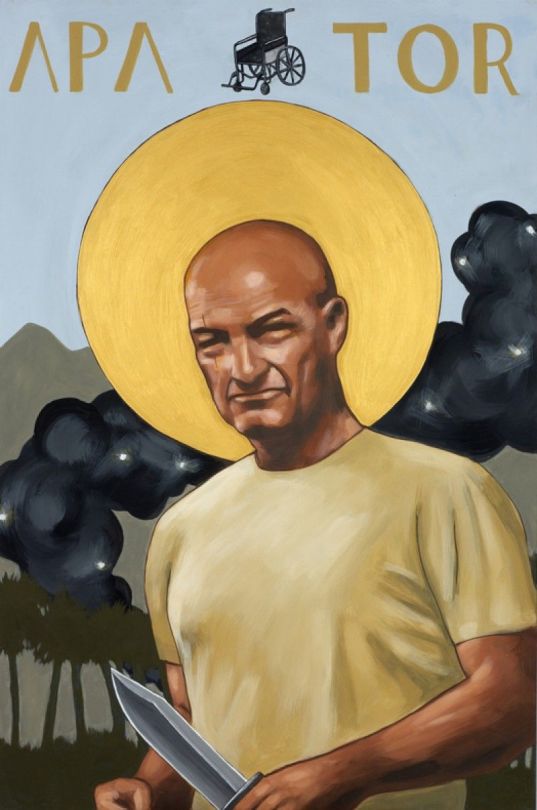
John, Patron Saint of the Fatherless, by Scott Erickson.
A painting made for the book The Gospel According to Lost by Chris Seay. Apator is Latin for “fatherless.” In LOST, John Locke grew up without a father, and when he found his father he was used, conned, and abandoned by him.
9 notes
·
View notes
Text
Austin gets weirder
Artist Ellsworth Kelly has finished a recent undertaking in a building designed to play with lighting, space, and line work. I found it very interesting the polarity of reaction I experience when looking at the photos of the interior against the exterior. I find the interior to be appealing and pleasing to the eye.
The exterior, however, really is off-putting to me. I find it very curious as to why this is. The same line shapes are used as well as spacial configuration (though one could argue that this spacial configuration being inverted is where the issues lies). However, for some reason the concave arcs with the rigid lines of the inside components is something I enjoy, while its inverse seems to be more confusing than anything else.
https://www.nytimes.com/2018/02/08/t-magazine/ellsworth-kelly-austin-last-work.html
Cheers,
Calvin
0 notes
Photo

Societal Role(s) of Art:
I think the most vital role that art inhabits is that of an empathic/empathetic translation widget. It has a unique ability to slice into an intimate moment/thought/place/event/etc. and extract a portion of that experience to an audience. That audience, coming from their own individual backgrounds and cultures, will approach the art with their subconscious (and conscious) biases. These biases can be products of sentimental, logical, inherited, or legitimate ignorance. These biases are malleable and reactant to events. One such event would be a powerful emotional reaction to a song. Another would be receiving a confounding meme from a friend. These are two ways in which I am affected by art, along with millions of others, on a daily basis. On the surface, these may seem like simple time fillers or blanket communication techniques.
Broadening my empathic perspective has been a goal of mine since my mid-twenties when I realized it was a glaring leadership flaw that I bore. I grew up mostly in a very small-minded group even though I had been to several other countries by the time I graduated high school. Racism and bigotry has plagued my family presumably for generations. My parents are considerably more forward leaning toward societal homeostasis than their parents were. I am more so than they were, but I am no saint; nor will my sons be. However, they will grow up in a house that doesn’t express worth based on race or gender. They will go on to raise strong men and women that are better still. This is all due to empathic perspective development, some of which is by way of a glimpse into another culture.
Let’s talk about what I intend by the term empathic perspective development. My grandparents were quite racist, to the point that I was prohibited to bring black friends to their house where I often spent my weekends. Their ability to see past a negative connotation (whether rational or irrational) was severely stunted. They were not motivated to chip-away at their inherited biases. I joined a Navy that wasn’t like the ships in the days of Carl Brashere with decks separated by ethnicity. I operated in a team that membership was based on your merit, capability, and team-ability. We were small but largely diverse in background. Any friction in the group due to something illogical (racism, sexism, etc.) would deal direct damage to our capabilities and ultimately our safety. The fact that it didn’t cause more of a disparity frankly confounded me while reflecting just now. I believe this to be resultant to the creation of a subculture based upon a severe and violent struggle underwent for entry to that particular community. This of course takes place in a series of “training and filtration exercises”. I was going to avoid going into a caveat on that, but I remembered that this is my blog. My project will continue this story, so please don’t feel as if I left you hanging.
Cheers,
Calvin
1 note
·
View note
Photo
As a Christian, I don’t believe my job is to fix all of the world’s ails. I have a particular path laid before me, but it isn’t one that leads neither to the union of all humanity nor to the eradication of social qualms (presumably). I grew up in a family of five children living on the income of considerably less than what I made my first year in the Navy, which wasn’t much. My mother is incredible. She is a spitfire southern and strong woman that carried our family through strength of will and an incessant notion of responsibility. We never had much, but we always had art supplies from the dollar store and books from the library. As an adult, I find myself questioning the quality of paint and brush that I purchase from the same stores for my sons to play with. As a child, I could always be found reading, drawing, painting, or building some hair-brained over-complicated contraption that accomplished something simple. We justified access to these supplies, though money was scarce, as a considerably inexpensive method of distraction and an affordable family past time. Paternally, I tend to go a bit overboard with family’s art supplies in quantity if not quality. However, my family and I are even more engaged in art than when I was a child. My sons both can spend hours drawing, color, painting, or building. My wife and I facilitate this through supplies and motivation because it’s one of the areas we find value in channeling creativity.
Human beings were created to appreciate aesthetic and sentimental beauty. I am in the infancy of re-justifying art into my daily life. We were programmed to create. That is one of the key differences between man and beast. We live in the easiest time to be alive in the history of the planet. Every society before us has had it worse than us in some glaring capacity. Yet, most archaeological digs unearth some piece of artistic evidence by way of an embellished tool or religious relic. In their world (which had WAY worse poverty, injustice, racism, sexism, etc.) they still managed to work art into their life. Why? There isn't a pulsing need for humans to create. In a world, you do not need to justify drinking water or eating food. Why must we justify art?
Cheers,
Calvin

Question of the Week
In a world with so many problems (things like poverty, injustice, racism, sexism….) how do you rationalize spending time and resources on art?
4 notes
·
View notes
Video
youtube


What is Art? What is an Artist? What is an artist’s role in society?
To begin our conversation about creative life as believers, I want to begin by acknowledging the initial challenge to find common definitions of art and the role of the artist, as a culture at large and as a culture of faith.
What is art to you? What isn’t art? How did you come to your definitions? How does your faith impact the way you answer this question?
Let’s talk about it together this week.
Please take some time before Wednesday August 26th to watch and read the following online content:
The Definition of Art video @ The Art Assignment (also attached above)
How do you Define Artist? @ Huff Post
What is the Artist’s Role in Society? @ Artwork Archive
Please post your thoughtful Reading Response Post about the course content above onto your blogs to help prepare you for our discussion coming up in a few weeks. (Details on requirements and grading for this reading reflection post can be found in your syllabus.)
Image above:
link from youtube of “The Definition of Art” video by The Art Assignment posted this past summer
two screenshots of different definitions of art from the video
3 notes
·
View notes
Text
Weekly Post
QOW
Reading Response
Discussion Response
0 notes